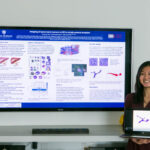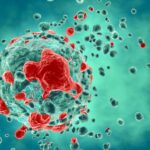Fueling Cell Movement

Everyone knows that cars require fuel, or energy, to move and get people from one destination to another. How much fuel the car will need though is dependent on a multitude of factors. Cars consume fuel based on the design of the car’s engine and body, but the environment outside of the car also influences fuel consumption, like terrain, wind, temperature, and road conditions.
Like cars, cells need to metabolize energy to move. And how a cell metabolizes its fuel, adenosine triphosphate, or ATP, is determined by environmental factors outside of the cell. But how much energy they consume to generate movement has never been studied in detail because measuring the metabolic activity of a single cell is extremely difficult to accomplish.
“Nobody buys a car by just looking under the hood—you buy it by the overall specs of the car like size, mpg (miles per gallon), etc. And when we look around there is very little measurement of performance factors like mpg for cells,” said Sean Sun, INBT core faculty member and professor of mechanical engineering.
While cells are not mechanical machines they share similar behaviors. Therefore knowing what a cell needs to generate forces and perform mechanical functions can help to understand cell movement.
“A lot of biological research is taking a car apart—naming the parts and deciphering what each part does,” said Sun. So rather than studying the activity as individual parts inside a cell, Sun and his colleagues want to know what determines the overall mpg of cell movement, and what external factors influence cell movement energetic requirements using the framework of energy balance and computational modeling.
It has been observed that cells can use different motility mechanisms to move depending on their environment. In a paper they published in PNAS, Sun and his team looked at two mechanisms of movement—actin-driven and water driven. In actin-driven movements, cells move similar to an inchworm—anchoring themselves to surrounding surfaces to push themselves forward. In water-driven movements (also called osmotic engine) the cells move like a jet engine, by taking in fluid and expelling it behind it to move forward.
Each movement was analyzed in different fluid environments, characterized by the hydraulic resistance of the environment. Hydraulic resistance depends on both viscosity and geometry of the microenvironment. Viscosity relates to the “thickness” of the environment. For example, it is harder to move through honey than water.
They found that actin-driven movement is inefficient in high hydraulic resistant environments because more energy is required, whereas water-driven movements becomes more efficient. It seems the best strategy for cell movement using the least amount of energy depends on the cell’s external environment. The energy efficiency of cell movement is also determined by the cell shape and the water permeability of their membrane.
Metabolic activity of cells is very helpful to know. Car manufacturers apply mpg to showcase fuel economy, but there are no mpg measurements for cells. Sun’s goal is to further understand cancer physics, metastasis in particular. His research can assist in locating the weak points in cancer cells and their processes, which can lead to better treatment methods for patients.
The next step is to experimentally measure cell metabolic activity with his colleague Konstantinos Konstantopoulos, INBT core faculty member and chemical and biomolecular engineering professor. Konstantopoulos also studies cancer metastasis and their physical environments using microfluidic devices that mimic the microenvironment of cancer cells.
“Designing and conducting experiments can take a long time, and this is where theoretical modeling and mathematics can help by offering new directions to explore and study biological processes, physiology, development, and so forth. It can help us determine if we are going in the right, or wrong, direction,” said Sun.
Story by Gina Wadas
Latest Posts
-
 Q&A with PSON Intern Jocelyn Hsu
August 19, 2021
Q&A with PSON Intern Jocelyn Hsu
August 19, 2021
-
 Start Up Founders from Johns Hopkins Aim to Stop Spread of Cancer
August 3, 2021
Start Up Founders from Johns Hopkins Aim to Stop Spread of Cancer
August 3, 2021
-
 Protein Appears to Prevent Tumor Cells from Spreading Via Blood Vessels
July 15, 2021
Protein Appears to Prevent Tumor Cells from Spreading Via Blood Vessels
July 15, 2021


